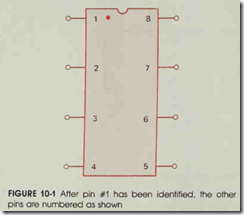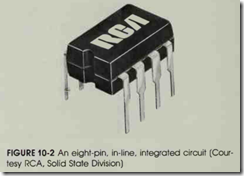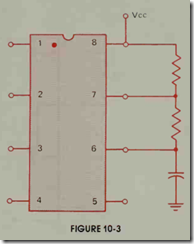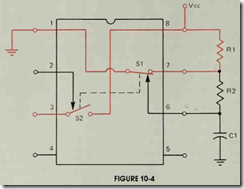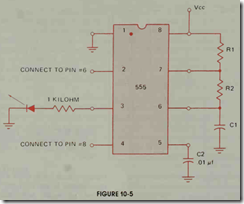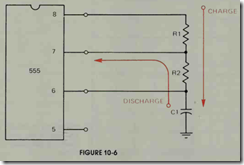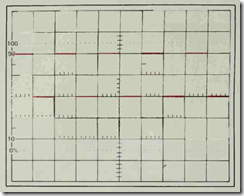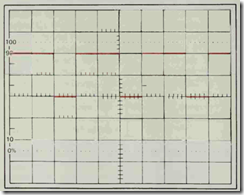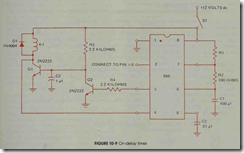Objectives
After studying this unit, the student will be able to:
• Describe the operation of the 555 timer
• Discuss the uses of the 555 timer
• Connect the timer as an oscillator
• Connect the 555 timer as an on-delay timer
The 555 timer is an eight-pin integrated cir cuit which has become one of the most popular electronic devices used in industrial electronic cir cuits. The reason for the 555’s popularity is its tre mendous versatility. The 555 timer is ust!d in cir cuits that require a time delay function, and is also used as an oscillator to provide the pulses needed to operate computer circuits.
The 555 timer is most often housed in an eight-pin, in-line integrated circuit (IC), figures 10-1 and 10-2. This package has a notch at one end, or a dot by one pin, which is used to identify pin # 1. Once pin # 1 has been identified, the other pins are numbered as shown in figure 10-1. The 555 timer operates on voltages that range from about 3 to 16 volts. Following is an expla nation of each pin and its function.
Pin #1 Ground-This pin is connected to cir cuit ground.
Pin #2 Trigger-Pin #2 must be connected to a voltage that is less than 1/3 Vee (the applied voltage) to trigger the unit. This usually is done by connecting pin #2 to ground. The connection to 1/3 Vcc or
ground must be momentary. If pin #2 is not removed from ground, the unit will not operate.
Pin #3 Output-The output turns on when Pin
#2 is triggered and turns off when the discharge is turned on.
Pin #4 Reset- When this pin is connected to
Vee, it permits the unit to operate. When it is connected to ground, it acti vates the discharge and keeps the timer from operating.
Pin #5 Control Voltage-If this pin is con nected to Vcc through a variable resistor, the on time is longer, but the off time is not affected. If pin #5 is connected to ground through a variable resistor, the on time is shorter, and the off time is still not affected. If pin #5 is not to be used in the circuit, it is usually taken to ground through a small capacitor. This helps to keep circuit noise from “talk ing” to pin #5.
Pin #6 Threshold-When the voltage across the capacitor connected to pin #6 reaches 2/3 the value of Vee, the discharge turns on and the output turns off.
Pin #7 Discharge- When pin #6 turns the dis
charge on, it discharges the capacitor connected to pin #6. The discharge re mains turned on until pin #2 retriggers the timer. The discharge then turns off and the capacitor connected to pin #6 begins charging again.
Pin #8 Vcc-Pin #8 is connected to Vcc.
(For the following explanation, assume that pin #2 is connected to pin #6. This permits the unit to be retriggered by the discharge each time it turns on and discharges the capacitor to 113 the value of Vee.)
The 555 timer operates on a percentage of the applied voltage. This permits the time setting to remain constant even if the applied voltage changes. For example, when the capacitor con nected to pin #6 reaches 2/3 of the applied volt age, the discharge turns on and discharges the ca pacitor until it reaches 113 of the applied voltage. If the applied voltage of the timer is connected to 12 volts de, 2/3 of the applied voltage is 8 volts
and 113 is 4 volts . This means that when the volt age across the capacitor connected to pin #6 reaches 8 volts, pin #7 will turn on until the ca pacitor is discharged to 113 the value of Vcc, or 4 volts, and will then turn off, figure 10-3.
If the voltage is lowered to 6 volts at Vcc, 2/3 of the applied voltage is 4 volts and 113 of the ap plied voltage is 2 volts. Pin #7 will now turn on when the voltage across the capacitor connected to pin #6 reaches 4 volts and will turn off when the voltage across the capacitor drops to 2 volts.
The formula for a RC time constant is (Time = Resistance X Capacitance). Notice that there is no mention of voltage in the formula. This means that it will take the same amount of time to charge the capacitor regardless of whether the circuit is connected to 12 volts or to 6 volts. If the time it takes for the voltage of the capacitor connected to pin #6 to reach 2/3 of Vee when the timer has an applied voltage of 12 volts is measured, it will be the same as the amount of time it takes when the applied voltage is only 6 volts. The timing of the circuit remains the same even if the voltage changes.
The circuit shown in figure 10-4 is used to explain the operation of the 555 timer. In figure 10-4, a normally closed switch, S 1, is connected between the discharge, pin #7, and the ground, pin #1. A normally open switch, S2, is connected between the output, pin #3, and Vee, pin #8.
The dotted line drawn between these two switches shows mechanical connection. This means that these switches operate together. If S1 opens, S2 closes at the same time. If S2 opens, Sl closes. Pin
#2, the trigger, and pin #6, the threshold, are used to control these switches. The trigger can close switch S2, and the threshold can dose S1.
To begin the analysis of this circuit, assume that switch Sl is closed and switch S2 is open as shown in figure 10-4. When the trigger is con nected to a voltage that is less than l/3 of Vee, it causes switch S2 to close and switch Sl to open. When switch S2 closes, voltage is supplied to the output at pin #3. When switch Sl opens, the dis charge is no longer connected to ground, and ca pacitor Cl begins to charge through resistors Rl and R2. When the voltage across C 1 reaches 2/3 of Vee, the threshold, pin #6, causes switch Sl to close and switch S2 to open. When switch S2 opens, the output turns off. When switch Sl closes, the discharge, pin #7, is connected to ground. Capacitor Cl then discharges through re sistor R2. The timer will remain in this position until the trigger is again connected to a voltage that is less than 113 of Vcc.
If the trigger is connected permanently to a voltage less than 113 of Vcc, switch S2 will be held closed and switch Sl will be held open. This, of course, will stop the operation of the timer. As stated previously, the trigger must be a momen-
tary pulse, not a continuous connection, in order for the 555 timer to operate.
CIRCUIT APPLICATIONS
The Oscillator
The 555 timer can perform a variety of func tions. One of the functions it is commonly used for is that of an oscillator. The 555 timer has be come popular for this application because it is so easy to use.
The 555 timer shown in figure 10-5 has pin
#2 connected to pin #6. This permits the timer to retrigger itself at the end of each time cycle. When the applied voltage is turned on, capacitor Cl is discharged and has a voltage of 0 volts across it. Since pin #2 is connected to pin #6, and the voltage at that point is less than 113 of Vee, the timer will trigger. When the timer is triggered, two things happen at the same time: the output turns on, and the discharge turns off. When the discharge at pin #7 turns off, capacitor Cl charges through resistors Rl and R2. The amount of time it takes for capacitor Cl to charge is deter mined by the capacitance of the capacitor and the combined resistance of Rl and R2.
When capacitor Cl is charged to a voltage
that is 2/3 of Vcc, the output turns off, and the discharge at pin #7 turns on. When the discharge turns on, capacitor C1 discharges through resistor R2 to ground. The amount of time it takes C1 to discharge is determined by the capacitance of ca pacitor C1 and the resistance of R2. When capac itor C 1 is discharged to a voltage that is 1/3 of Vee, the timer is retriggered by pin #2 causing the output to turn on and the discharge to turn off. When the discharge turns off, capacitor C1 begins charging again.
The amount of time required to charge capac itor C1 is determined by the combined resistance of R1 and R2. The discharge time , however, is determined by the value of R2, figure 10-6.
Since the timer’s output is turned on while capacitor C1 is charging, and turned off while C1 is discharging, the on time of the output is longer than the off time. If the value of resistor R2 is much greater than the value of resistor R1, this condition is not too evident. For example , if resistor R1 has a value of 1 kilohm and R2 has a value of 100 kilohms, the resistance connected in series with the capacitor during charging is 101 kilohms. The resistance connected in series with the capac itor during discharge is 100 kilohms. In this cir cuit, the difference between the charge time and the discharge time of the capacitor is 1%. If an oscilloscope is connected to the output of the timer, a waveform similar to the waveform shown in figure 10-7 will be seen.
Assume that the value of resistor R1 is changed to 100 kilohms and the value of resistor R2 remains at 100 kilohms. In this circuit, the resistance connected in series with the capacitor dur ing charging is 200 kilohms. The resistance con nected in series with the capacitor during discharge, however, is 100 kilohms. Therefore, the discharge time is 50% of the charge time. This means that the output of the timer will be turned on twice as long as it will be turned off. An oscil loscope connected to the output of the timer would display a waveform similar to the one shown in figure 10-8.
Although this condition can exist, the 555 timer has a provision for solving the problem. Pin
#5, the control voltage pin, can give complete
control of the output voltage. If a variable resistor is connected between pin #5 and Vee, the on time of the output can be lengthened to any value de sired. If a variable resistor is connected between pin #5 and ground, the on time of the output can be shortened to any value desired. Since the on time of the timer is adjusted by connecting resis tance to pin #5, the off time is set by the values of C1 and R2.
The output frequency of the unit is deter mined by the values of capacitor C1 and resistors R1 and R2. The 555 timer will operate at almost any frequency desired. It is used in many indus trial electronic circuits that require the use of a square wave oscillator.
The On-Delay Timer
In this circuit, the 555 timer is used to con struct an on-delay relay. The 555 produces accu rate time delays which can range from seconds to hours depending on the values of resistance and capacitance used in the circuit. In figure 10-9,
transistor Q1 is used to switch relay coil K1 on or off. A transistor is used to control the relay be cause the 555 timer may not be able to supply the current needed to operate it.
Transistor Q2 is used as a stealer transistor to steal the base current from transistor Ql. As long as transistor Q2 is turned on by the output of the timer, transistor Q1 is turned off.
Capacitor C3 is connected from the base of
transistor Q1 to ground. Capacitor C3 acts as a short time-delay circuit. When Vee is turned on by switch S1, capacitor C3 is discharged. Before transistor Q1 can be turned on, capacitor C3 must be charged through resistor R3. This charging time is only a fraction of a second, but it insures that transistor Q1 will not turn on before the out put of the timer can turn transistor Q2 on. Once transistor Q2 has been turned on, it will hold tran sistor Q1 off by stealing its base current.
Diode D 1 is used as a kickback or freewheel
ing diode to kill the spike voltage induced into the coil of relay K1 when switch S1 is opened. Resis tor R3 limits the base current to transistor Q1 and
resistor R4 limits the base current to transis tor Q2.
Pin #4, the reset pin, is used as a latch in this circuit. When power is applied at Vee, tran sistor Q1 is turned off. Since transistor Q1 is off, most of the applied voltage is dropped across the transistor, causing about 12 volts to appear at the collector of the transistor. Since pin #4 is con nected to the collector of transistor Q1, 12 volts is applied to pin #4. For the timer to operate, pin
#4 must be connected to a voltage that is greater than 2/3 of Vee. When pin #4 is connected to a voltage that is less than 113 of Vee, it turns on the discharge and keeps the timer from operating. When transistor Q1 turns on, the collector of the transistor drops to ground or 0 volts. Pin #4 is also connected to ground, which prevents the timer from further operation. Since the timer can no longer operate, the output remains turned off, which permits transistor Q1 to remain turned on.
Capacitor C1 and resistors R1 and R2 are used to set the amount of time delay. Resistor R2 should be kept at a value of about 100 ohms. The job of resistor R2 is to limit the current when ca pacitor C1 discharges. Resistor R2 has a relatively low value to enable capacitor C1 to discharge quickly. The time setting can be changed by changing the value of resistor R1.
To understand the operation of the circuit, assume that switch S1 is open and all capacitors are discharged. When switch S1 is closed, pin #2 which is connected to 0 volts, triggers the timer. When the timer is triggered, the output activates transistor Q2 which steals the base current from transistor Q1. Transistor Q1 remains off as long as transistor Q2 is on. When capacitor C1 has been charged to 2/3 of Vcc, the discharge turns on and the output of the timer turns off. When the output turns transistor Q2 off, transistor Q1 is supplied with base current through resistor R3 and turns on relay coil Kl. When transistor Q1 is turned on, the voltage applied to the reset pin, #4, is changed from 12 volts to 0 volts. This causes the reset to lock the discharge on and the output off. Therefore, when transistor Q1 is turned on, switch S1 must be reopened to reset the circuit.
REVIEW QUESTIONS
1. How is pin # 1 of an in-line, integrated circuit identified?
2. A 555 timer is connected to produce a pulse at the output once each second.
The timer is connected to 12 volts de. If the voltage is reduced to 8 volts de, the 555 will continue to operate at the same pulse rate. Explain why the timer will operate at the same pulse rate when the voltage is reduced.
3. What is the range of voltage the 555 timer will operate on?
4. Explain the function of the control voltage, pin #5, when the timer is being
used as an oscillator.
5. Explain what happens to the output and discharge pins of the 555 timer when the trigger, pin #2, is connected to a voltage that is less than 1/3 of Vee.
6. Explain what happens to the output and discharge pins when the threshold,
pin #6, is connected to a voltage that is greater than 2/3 of Vee.
7. Refer to figure 10-6. The values of what components determine the length of
time the output will be turned on?
8. The values of what components determine the amount of time the output will
remain turned off?
9. Explain the operation of pin #4 on the 555 timer.
10. What is a stealer transistor?
